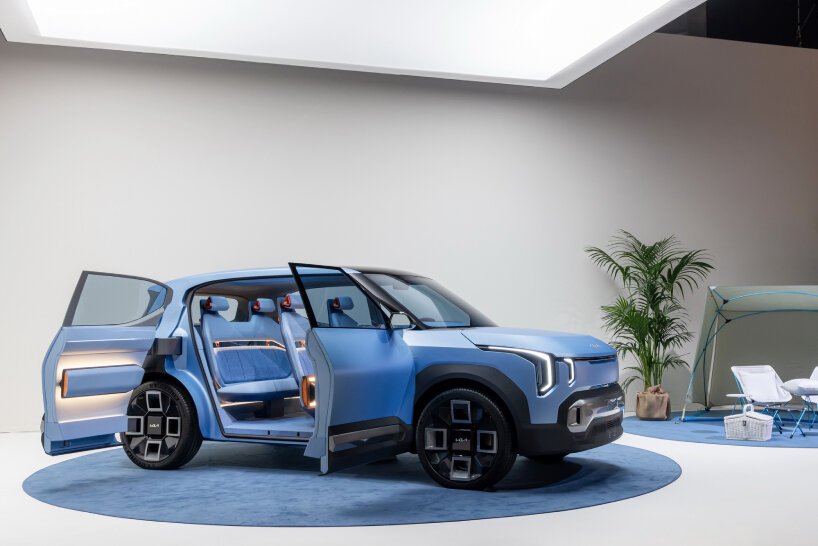Kia electric SUV EV2 with biomaterial parts in the cabin
Kia reveals the interior design of its concept electric SUV EV2 at Milan Design Week 2025, made of hemp, mycelium, flax fibers, and recycled textiles. As part of the exhibition Transcend Journey at Eastend Studios, visitors can see the cabin of the concept vehicle for the first time. One of the first biomaterial elements the design team applies is the cellulose-based Simplifyber Fybron from renewable sources such as wood, paper, and recycled textiles.
It emerges at the Kia electric SUV EV2’s dashboard and door panels. This ingredient comes through a liquid-based process, eliminating the need for weaving or spinning. The team also integrates biodegradable mycelium-based components into the interiors, courtesy of Biomyc. These materials include hemp and mycelium, which are grown and colored to match Kia’s Pantone specifications for visual consistency throughout the cabin.

all images courtesy of Kia
Mycelium-based materials for the interior surfaces
There are two types of mycelium that Kia’s design team uses for the electric SUV EV2. The first is mycelium-infused polyurethane, applied across light blue interior surfaces, containing visible mycelium particles. The second is a grown volume material, produced by mycelium cells binding with cellulose from agricultural waste. This solid structure is used in components such as the door armrest, where it provides insulation.Inside the Kia electric SUV EV2, the team also incorporates a bio-based composite made from flax fibers named AmpliTex, courtesy of Bcomp.
It shows up in the back seat shell and front seat substructures of the concept vehicle. The use of this component replaces traditional synthetic materials, which helps reduce the overall vehicle weight. AmpliTex is also fully recyclable. At the end of its use, companies can process it into composite pellets for reuse. Kia’s Color, Materials, and Finish (CMF) team has also developed a dark-blue finish for the material to align with the vehicle’s overall design.

exhibition view of Transcend Journey with the electric Kia concept model
From concept to real-life model starting 2026
Aside from the biomaterials in the cabin, the Kia electric SUV EV2 features seat headrest-integrated speakers, portable door speakers, side-extendable seats, detachable seat cushions, and pop-up luggage dividers. The vehicle is also capable of sending message lighting to the pedestrians crossing so they know that car has stopped to make way. The interior is also configurable. This means that the Kia electric SUV EV2 has a rear bench that can be lifted. It reveals a flat floor that can double as a ‘living room’ inside the car.
The vehicle also comes with rear-hinged back doors so it opens up more for easy entry. Then, the front section features vertical daytime running lights and an open lighting structure without a cover lens. The bumpers and lower sections have contrasting graphic elements, which contribute to the concept vehicle’s utility-focused design. The profile of the Kia electric SUV EV2 evidently includes a straight shoulder line that connects the front and rear sections. The solid fenders contrast with geometric glass shapes and wheel arches to define the vehicle’s form. First unveiled in February 2025, the Kia electric SUV EV2 expects to hit the market in 2026.

the exhibition takes place at Eastend Studios between April 7th to 9th, 2025

the interior parts uses biomaterials such as mycelium and hemp

dashboard view of the electric vehicle

the car also features seat headrest-integrated speakers, portable door speakers and side-extendable seats












